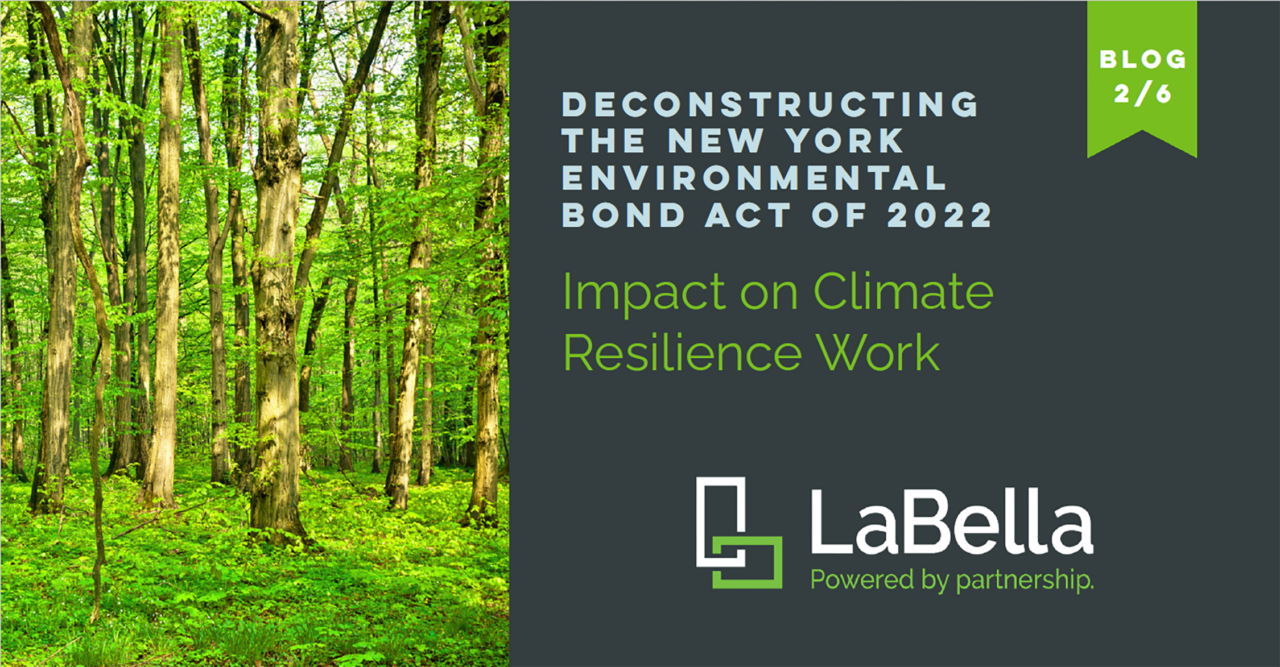The NYS Environmental Bond Act’s Impact on Climate Resilience Work

The newly passed Clean Water, Clean Air, and Green Jobs Environmental Bond Act of 2022 is the first bond act passed in New York State with the specific intent to prepare New York State for the impacts of climate change. The combined impacts of sea level rise, rising temperatures, and increased precipitation could be catalysts for a large increase in flooding within the state of New York. Hurricane Sandy in 2012 and Hurricane Ida in 2021 affected large portions of New York City, resulting in significant loss of life and property and infrastructure damage. Flooding has also impacted smaller, more rural communities across the state, with long-lasting damage and prolonged recovery periods.
The Environmental Bond Act affords the opportunity to update our infrastructure for the 21st century and beyond. Funding opportunities are broken into four categories, but there is significant overlap between these “funding buckets.” Our team has broken down how climate resilience initiatives are present in each of the four main “buckets” identified in the Act:
Restoration and Flood Risk Reduction
Sea level rise, storm preparedness, flood risk reduction and mitigation, and natural environment restoration projects are set to receive funding from New York State under the Act. Flooding presents a risk over a wide range of geographies, and funding will be available for a variety of solutions that focus on restoration of the natural environment.
What kind of restoration and flood mitigation solutions will be funded from this “bucket”? At least $100 million is earmarked for coastal rehabilitation and shoreline restoration projects that address sea level rise, erosion, and marine or lacustrine flooding and erosion. Nature-based solutions, such as bank regrading and stabilization, marsh and wetlands creation, beach and dune nourishment, and planted revetments will be given consideration for funding. These projects will be focused both on sea level rise and on Great Lakes erosion. Projects to “right-size” existing infrastructure will also be open to funding, as long as this work provides tangible flood risk reduction benefits.
Flooding due to sea level rise isn’t the only concern. Changes in annual precipitation and development patterns already has and will continue to affect inland areas. At least $100 million is earmarked to help address inland flooding. Floodplain reconnection and restoration, wetland and stream restoration, forest conservation, and habitat restoration projects will all be eligible for funding. Additionally, at least $250 million will be available for “voluntary buyout” programs – this will be available to municipalities where development has previously occurred within a FEMA floodplain, and structures have experienced repeated flooding events.
Open Space Land Conservation and Recreation
Why is open space land conservation tied to climate change? Forests trap and convert carbon dioxide, stabilize topsoil, slow the migration of stormwater into streams and rivers, and provide critical habitat that encourages diversity of wildlife. They also provide recreational opportunities for humans and help improve the quality of life for New Yorkers.
At least $300 million will be available for open space land conservation. Funding for open space land conservation will allow the New York State Office of Parks, Recreation, and Historic Preservation (as well as local municipalities) to acquire land for future preservation and improve existing recreational infrastructure. Up to $75 million will be available for fish hatchery creation and upgrades, which will provide a boost to a major recreational economic driver in New York State.
The Act also calls for funding for land conservation in the form of farmland protection. Loss of topsoil and soil fertility due to erosion and poor land management practices is a major concern for food security as we move further into the 21st century. Under the Act, funding will be available to purchase conservation easements to protect farmland to county agricultural and farmland protection boards, municipalities, soil and water conservation districts, and not-for-profit corporations. At least $150 million will be available for farmland protection projects.
Climate Change Mitigation
Funding available from this “bucket” will be available to projects that help mitigate climate change through carbon and methane emissions reduction as well as projects that help communities adapt to the effects of climate change. This funding focuses more on urban areas, while the other two “buckets” described above focus more on rural areas.
Let’s start with eligible emissions reduction projects. At least $100 million will be available for climate adaptation and mitigation projects. Projects such as manure storage through cover or methane reduction technologies that utilize natural and working lands will be eligible, as well as projects that reduce or eliminate air pollution from various sources that affect disadvantaged communities. Funding will also be available for urban forest and habitat restoration, with a focus on planting of street trees and expanding urban tree canopies.
Funding will also be available to help urban areas adapt to the effects of climate change. Green roofs, open space protection, community gardens, cool pavement projects, and community cooling centers that combat urban heat island effects are eligible. At least $200 million will be available for air and water pollution elimination in disadvantaged communities, and at least $400 million will be available for green building projects.
Water Quality Improvement and Resilient Infrastructure
Over the past two centuries, human beings have designed systems to collect, convey, and discharge water to natural water bodies as quickly as possible. This has had a cumulative negative effect on water quality. Under the Act, projects aimed at improving stormwater, agricultural runoff, and groundwater quality will be eligible under this “bucket.”
Beginning with stormwater, funding will be available to municipalities for projects that reduce or control stormwater runoff, particularly using green infrastructure. Funding will also be available for projects such as comprehensive nutrient management plans, agricultural nutrient management projects, and non-point source abatement and control programs. These types of projects are aimed at reducing nutrient runoff from agricultural areas and promoting soil health. Additionally, funding will be available for projects that address harmful algal blooms, such as nitrogen reduction projects for marine environments and phosphorus reduction projects in lacustrine environments. At least $250 million will be available for municipal stormwater projects that address these kinds of issues.
Finally, the Act allocates funding for projects that address failing septic systems of cesspools, including extending or establishing sewer lines to new areas previously served by private systems. Funding will also be available for projects aimed at reducing, avoiding, or eliminating point and non-point source discharges to ambient water bodies. At least $250 million will be available for these types of projects.
What’s Next?
Next up, our team will explore how municipalities can get a piece of the pie under the Act. We’ll take a look at how funding may be distributed, what your municipality needs to do to prepare, and strategies for improving your chances at being awarded funding.
Missed the first article in this series? Check it out below!
Introduction to the NYS Environmental Bond Act of 2022

About the Author
Jared Pristach, PEEnvironmental Engineer
Jared is an Environmental Project Manager and Environmental Engineer responsible for the coordination and successful completion of climate resilience projects and solar array development. He currently manages the Brownfield Cleanup Program’s shoreline resilience and solar design projects. Jared’s project experience includes Phase I and Phase II Environmental Site Assessments; New York State Department of Environmental (NYSDEC) State Superfund projects, including remedial design and construction oversight; remedial systems operation and maintenance; green infrastructure design; civil engineering site design; shoreline and streambank resilience planning; and structural engineering design of recreational facilities.